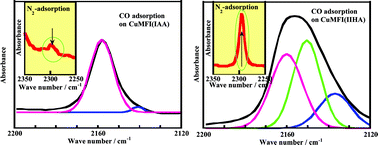Identification of two types of exchangeable sites for monovalent copper ions exchanged in MFI-type zeolite†
Abstract
Three different approaches have been used to characterize the state of exchanged

* Corresponding authors
a
Department of Fundamental Materials Science, Graduate School of Natural Science and Technology, Okayama University, Tsushima, Japan
E-mail:
kuroda@cc.okayama-u.ac.jp
Fax: +81-86-251-7853
Tel: +81-86-251-7844
b Research Laboratory for Surface Science, Faculty of Science, Okayama University, Tsushima, Japan
Three different approaches have been used to characterize the state of exchanged

 Please wait while we load your content...
Something went wrong. Try again?
Please wait while we load your content...
Something went wrong. Try again?
T. Mori, A. Itadani, E. Tabuchi, Y. Sogo, R. Kumashiro, M. Nagao and Y. Kuroda, Phys. Chem. Chem. Phys., 2008, 10, 1203 DOI: 10.1039/B713587D
To request permission to reproduce material from this article, please go to the Copyright Clearance Center request page.
If you are an author contributing to an RSC publication, you do not need to request permission provided correct acknowledgement is given.
If you are the author of this article, you do not need to request permission to reproduce figures and diagrams provided correct acknowledgement is given. If you want to reproduce the whole article in a third-party publication (excluding your thesis/dissertation for which permission is not required) please go to the Copyright Clearance Center request page.
Read more about how to correctly acknowledge RSC content.
 Fetching data from CrossRef.
Fetching data from CrossRef.
This may take some time to load.
Loading related content
